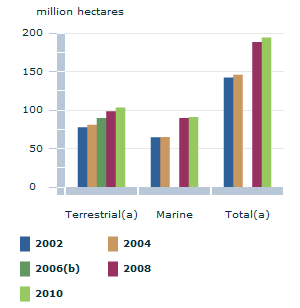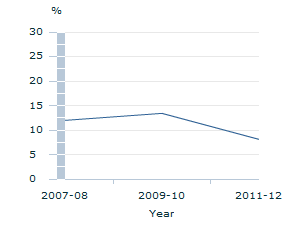|
|
This page contains the following further information for protecting the environment:
|
GLOSSARY
International Union for the Conservation of Nature (IUCN) Protected Area Management Categories
Category IA – Strict Nature Reserve: Protected area managed mainly for science.
Category IB – Wilderness Area: Protected area managed mainly for wilderness protection.
Category II – National Park: Protected area managed mainly for ecosystem protection and recreation.
Category III – Natural Monument: Protected area managed for conservation of specific natural features.
Category IV – Habitat/Species Management Area: Protected area managed mainly for conservation through management intervention.
Category V – Protected Landscape/Seascape: Protected area managed mainly for landscape/seascape conservation and recreation.
Category VI – Managed Resource Protected Areas: Protected area managed mainly for the sustainable use of natural ecosystems.
Protected areas
The International Union for Conservation of Nature defines a protected area as 'a clearly defined geographical space, recognised, dedicated and managed, through legal or other effective means, to achieve the long term conservation of nature with associated ecosystem services and cultural values'. (Dudley, 2008)
|
REFERENCES
ABS, 2003, Environmental impacts of agriculture' in Year Book Australia, 2003 (cat. no. 1301.0)
ABS, 2013, Land Management and Farming in Australia, 2011-12 (cat. no. 4627.0)
Australian Government Department of the Environment, 2013, 'Collaborative Australian Protected Area Databases' (1997 to 2012), <http://www.environment.gov.au/>
Dudley, N (ed.), 2008, 'Guidelines for Applying Protected Areas Management Categories' IUCN: Gland, Switzerland. p.8-9. <http://data.iucn.org/dbtw-wpd/edocs/PAPS-016.pdf>
National Reserve System Task Group, 2009, Strategy for Australia's National Reserve System 2009-2030 <http://www.environment.gov.au/>
State of the Environment 2011 Committee, 2011, 'Australia: State of the environment, 2011', Independent report to the Australian Government Minister for Sustainability, Environment, Water, Population and Communities, Canberra, DSEWPaC <http://www.environment.gov.au/>
United Nations Environment Programme, 2013, IUCN Management Categories
|
Click on the links below to be taken to a summary of the graphs from the corresponding tab within the protecting the environment theme:
Protect
Prevent and minimise further damage
|
| PROTECT |
 |
Protected areas |
 |  |  |
 |  |  |
Progress indicator |  | ...that are IUCN Category V-VI(a) |

Footnote:
(a) External territories are excluded.
(b) 2006 data is not available for Marine and/or Total.
Source:
Australian Government Department of the Environment, Collaborative Australian Protected Area Databases (1997, 2000, 2002, 2004, 2006, 2008, 2010) |  | 
Footnote:
(a) International Union for the Conservation of Nature (IUCN) Management Categories V and VI offer a higher level of human use than the lower categories do.
(b) 2006 data is not available for Marine.
(c) The 2010 data includes a small amount of external territories which are otherwise excluded.
Source:
Australian Government Department of the Environment, Collaborative Australian Protected Area Databases (1997, 2000, 2002, 2004, 2006, 2008, 2010) |
 |  | |
 |  |  |
 |  |  |
|
| PREVENT AND MINIMISE FURTHER DAMAGE |
 |
Native vegetation and wetlands on agricultural holdings protected for conservation purposes |
 |  |  |
 |  |  |
Progress indicator |  |  |

Footnote:
^ 2007-08 estimate has a relative standard error of 10% to less than 25% and should be used with caution.
Source:
ABS Land Management and Farming in Australia, 2011-12 (cat. no. 4627.0) |  |  |
 |  | |
|
|
|